The Intel SSD 660p SSD Review: QLC NAND Arrives For Consumer SSDs
by Billy Tallis on August 7, 2018 11:00 AM ESTAnandTech Storage Bench - Heavy
Our Heavy storage benchmark is proportionally more write-heavy than The Destroyer, but much shorter overall. The total writes in the Heavy test aren't enough to fill the drive, so performance never drops down to steady state. This test is far more representative of a power user's day to day usage, and is heavily influenced by the drive's peak performance. The Heavy workload test details can be found here. This test is run twice, once on a freshly erased drive and once after filling the drive with sequential writes.
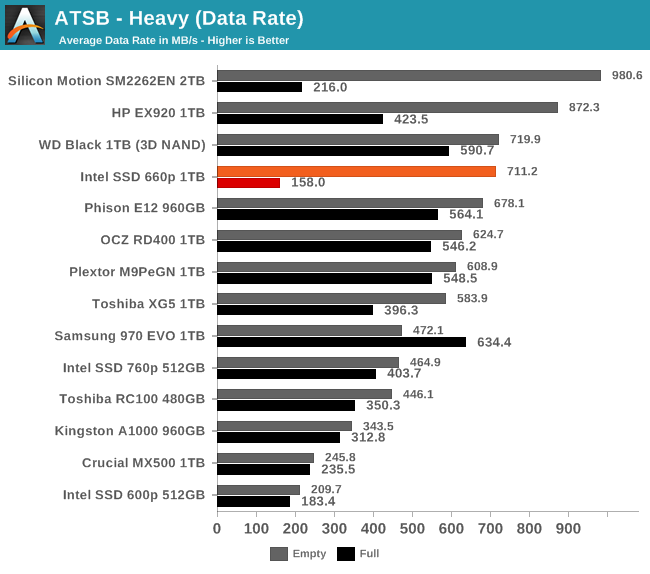
When the Heavy test is run on an empty Intel SSD 660p, the test is able to operate almost entirely within the large SLC cache and the average data rate is competitive with many high-end NVMe SSDs. When the drive is full and the SLC cache is small, the low performance of the QLC NAND shows through with an average data rate that is slower than the 600p or Crucial MX500, but still far faster than a mechanical hard drive.
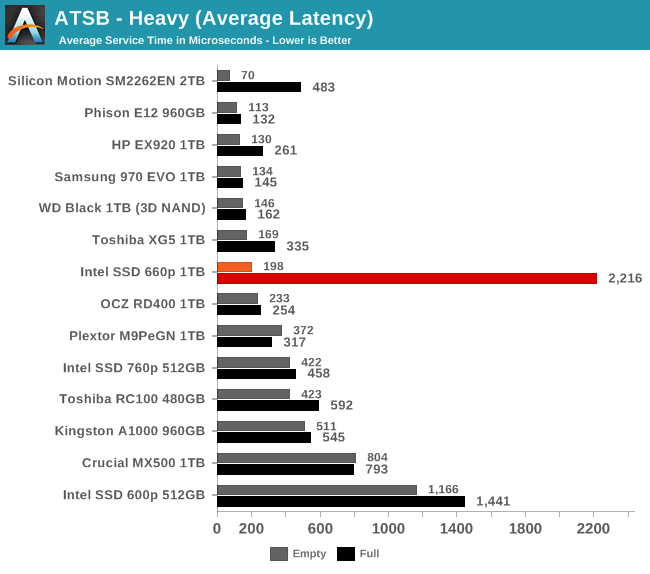
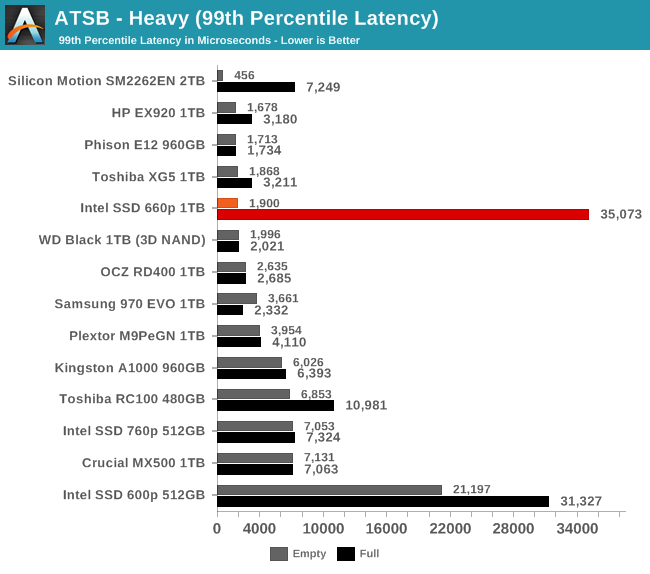
The average and 99th percentile latency scores of the 660p on the empty-drive test run are clearly high-end; the use of a four-channel controller doesn't seem to be holding back the performance of the SLC cache. The full-drive latency scores are an order of magnitude higher and worse than other SSDs of comparable capacity, but not worse than some of the slowest low-capacity TLC drives we've tested.
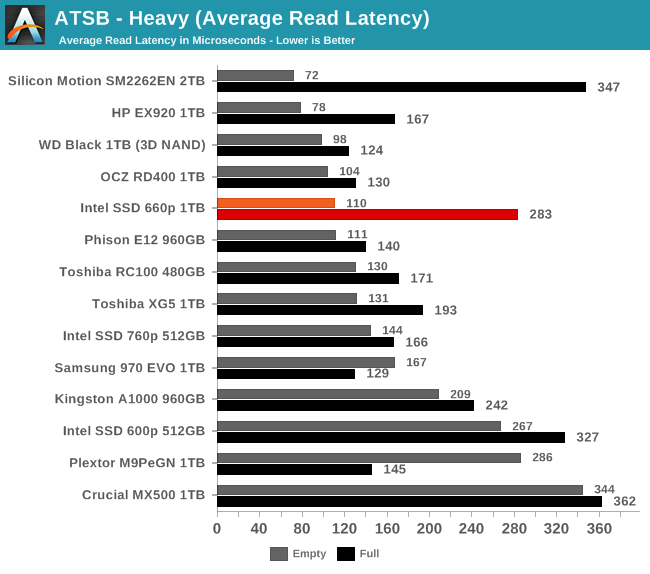
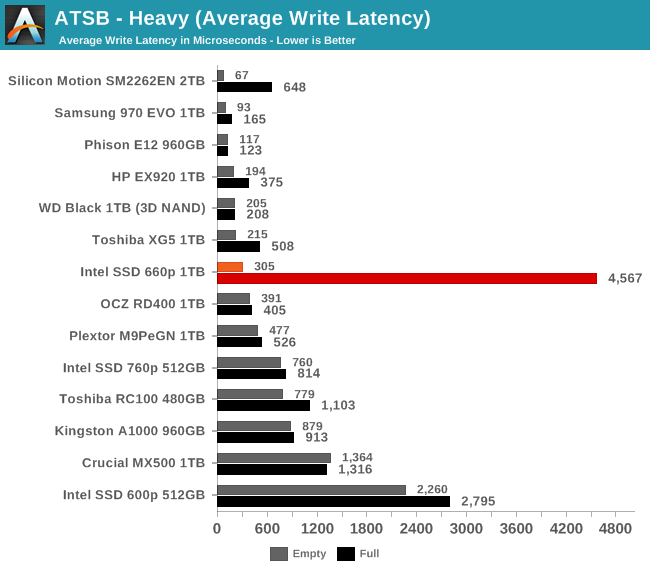
The average read latency of the Intel 660p on the Heavy test is about 2.5x higher for the full-drive test run than when the test is run on a freshly-erased drive. Neither score is unprecedented for a NVMe drive, and it's not quite the largest disparity we've seen between full and empty performance. The average write latency is where the 660p suffers most from being full, with latency that's about 60% higher than the already-slow 600p.
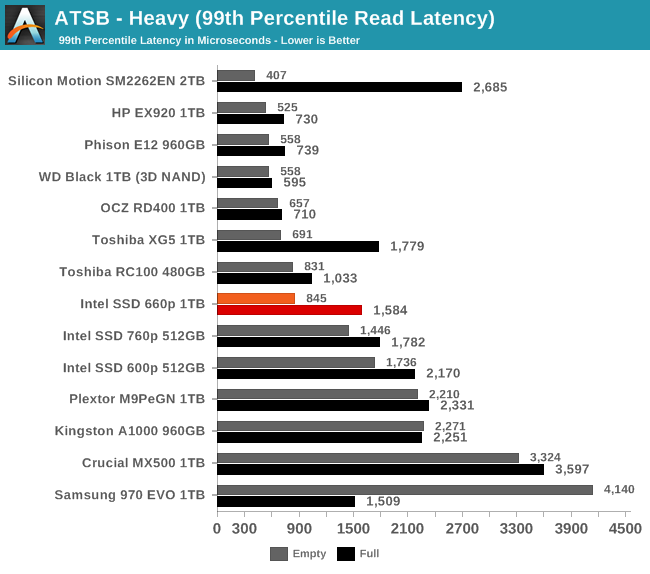
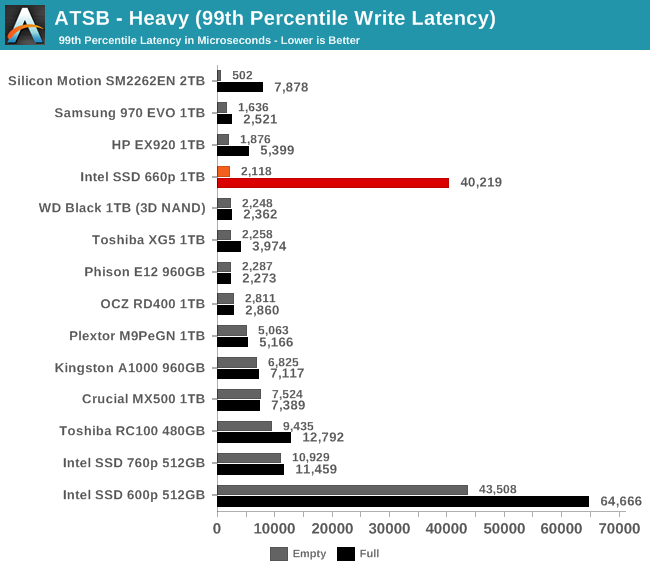
The 99th percentile read latency scores from the 660p are fine for a low-end NVMe drive, and close to high-end for the empty-drive test run that is mostly using the SLC cache. The 99th percentile write latency is similarly great when using the SLC cache, but almost 20 times worse when the drive is full. This is pretty bad in comparison to other current-generation NVMe drives or mainstream SATA drives, but is actually slightly better than the Intel 600p's best case for 99th percentile write latency.
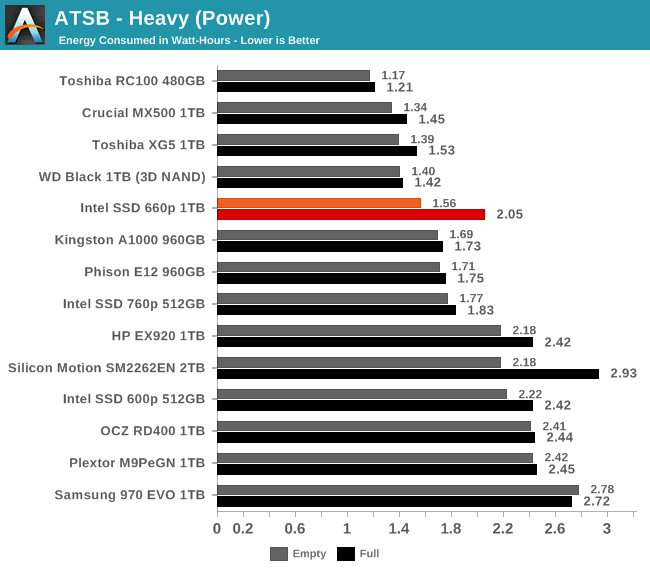
The Intel SSD 660p shows above average power efficiency on the Heavy test, by NVMe standards. Even the full-drive test run energy usage is lower than several high-end drives.










86 Comments
View All Comments
DanNeely - Tuesday, August 7, 2018 - link
Over 18 months between 2013 and 2015 Tech Report tortured a set of early generation SSDs to death via continuous writing until they failed. I'm not aware of anyone else doing the same more recently. Power off retention testing is probably beyond anyone without major OEM sponsorship because each time you power a drive on to see if it's still good you've given its firmware a chance to start running a refresh cycle if needed. As a result to look beyond really short time spans, you'd need an entire stack of each model of drive tested.https://techreport.com/review/27909/the-ssd-endura...
Oxford Guy - Tuesday, August 7, 2018 - link
Torture tests don't test voltage fading from disuse, though.StrangerGuy - Tuesday, August 7, 2018 - link
And audiophiles always claim no tests are ever enough to disprove their supernatural hearing claims, so...Oxford Guy - Tuesday, August 7, 2018 - link
SSD defects have been found in a variety of models, such as the 840 and the OCZ Vertex 2.mapesdhs - Wednesday, August 8, 2018 - link
Please explain the Vertex2, because I have a lot of them and so far none have failed. Or do you mean the original Vertex2 rather than the Vertex2E which very quickly replaced it? Most of mine are V2Es, it was actually quite rare to come across a normal V2, they were replaced in the channel very quickly. The V2E is an excellent SSD, especially for any OS that doesn't support TRIM, such as WinXP or IRIX. Also, most of the talk about the 840 line was of the 840 EVO, not the standard 840; it's hard to find equivalent coverage of the 840, most sites focused on the EVO instead.Valantar - Wednesday, August 8, 2018 - link
If the Vertex2 was the one that caused BSODs and was recalled, then at least I had one. Didn't find out that the drive was the defective part or that it had been recalled until quite a lot later, but at least I got my money back (which then paid for a very nice 840 Pro, so it turned out well in the end XD).Oxford Guy - Friday, August 10, 2018 - link
Not recalled. There was a program where people could ask OCZ for replacements. But, OCZ also "ran out" of stock for that replacement program and never even covered the drive that was most severely affected: the 240 GB 64-bit NAND unit.BurntMyBacon - Wednesday, August 8, 2018 - link
I believe the problems that plagued the 840 EVO were relevant to the 840 based on two facts. Both SSDs used the same flash. Samsung eventually released a (partial) fix for the 840 similar to the 840 EVO. The fix was apparently incompatible with Linux/BSD, though.Spunjji - Wednesday, August 8, 2018 - link
You'd also be providing useless data by doing so. The drives will have been superseded at least twice before you even have anything to show from the (very expensive) testing.JoeyJoJo123 - Tuesday, August 7, 2018 - link
>muh ssd endurance boogeymanLike clockwork.